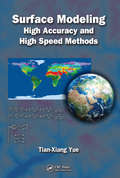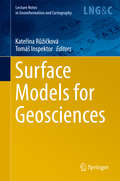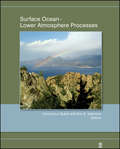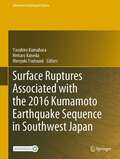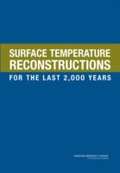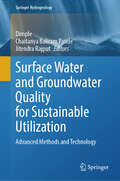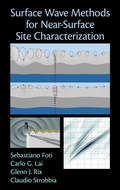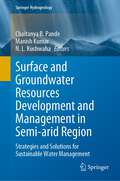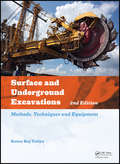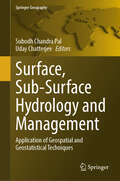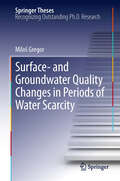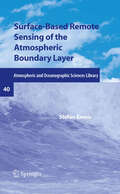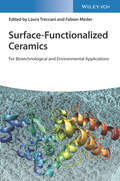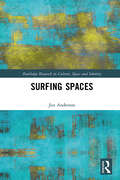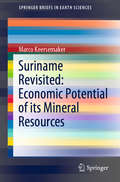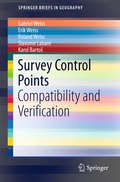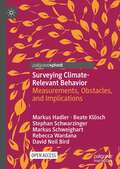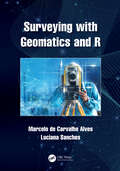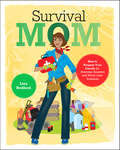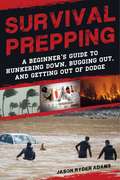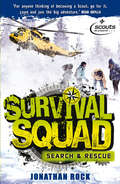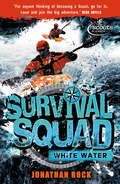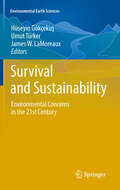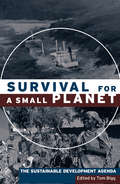- Table View
- List View
Surface Modeling: High Accuracy and High Speed Methods (Applied Ecology and Environmental Management)
by Tian-Xiang YueAlthough GIS provides powerful functionality for spatial analysis, data overlay and storage, these spatially oriented systems lack the ability to represent temporal dynamics, which is a major impediment to its use in surface modeling. However, rapid development of computing technology in recent years has made real-time spatial analysis and real-tim
Surface Models for Geosciences
by Tomáš Inspektor Kateřina RůžičkováThe aim of the conference is to present and discuss new methods, issues and challenges encountered in all parts of the complex process of gradual development and application of digital surface models. This process covers data capture, data generation, storage, model creation, validation, manipulation, utilization and visualization. Each stage requires suitable methods and involves issues that may substantially decrease the value of the model. Furthermore, the conference provides a platform to discuss the requirements, features and research approaches for 3D modeling, continuous field modeling and other geoscience applications. The conference covers the following topics: - LIDAR for elevation data - Radar interferometry for elevation data - Surface model creation - Surface model statistics - Surface model storage (including data formats, standardization, database) - Feature extraction - Analysis of surface models - Surface models for hydrology, meteorology, climatology - Surface models for signal spreading - Surface models for geology (structural, mining) - Surface models for environmental science - Surface models for visibility studies - Surface models for urban geography - Surface models for human geography - Uncertainty of surface models and digital terrain analysis - Surface model visual enhancement and rendering
Surface Ocean: Lower Atmosphere Processes
by Corinne Le Quéré Eric S. SaltzmanPublished by the American Geophysical Union as part of the Geophysical Monograph Series, Volume 187.The focus of Surface Ocean: Lower Atmosphere Processes is biogeochemical interactions between the surface ocean and the lower atmosphere. <P><P>This volume is an outgrowth of the Surface Ocean-Lower Atmosphere Study (SOLAS) Summer School. The volume is designed to provide graduate students, postdoctoral fellows, and researchers from a wide range of academic backgrounds with a basis for understanding the nature of ocean-atmosphere interactions and the current research issues in this area.<P>The volume highlights include the following:Background material on ocean and atmosphere structure, circulation, and chemistry and on marine ecosystemsIntegrative chapters on the global carbon cycle and ocean biogeochemistryIssue-oriented chapters on the iron cycle and dimethylsulfideTool-oriented chapters on biogeochemical modeling and remote sensingA framework of underlying physical/chemical/biological principles, as well as perspectives on current research issues in the field.The readership for this book will include graduate students and/or advanced undergraduate students, postdoctoral researchers, and researchers in the fields of oceanography and atmospheric science. It will also be useful for experienced researchers in specific other disciplines who wish to broaden their perspectives on the complex biogeochemical coupling between ocean and atmosphere and the importance of this coupling to understanding global change.
Surface Ruptures Associated with the 2016 Kumamoto Earthquake Sequence in Southwest Japan (Advances in Geological Science)
by Yasuhiro Kumahara Heitaro Kaneda Hiroyuki TsutsumiIn April 2016, a series of earthquakes hit the Kumamoto area of Kyushu Island, southwest Japan. The Mj 7.3 (Mw 7.0) mainshock produced extensive and complex surface ruptures in and around the active Futagawa-Hinagu fault zone, including primary right-lateral faulting, slip-partitioned normal faulting, and distributed and triggered surface breaks, as well as minor surface ruptures associated with the foreshocks of up to Mj 6.5 (Mw 6.2). This book provides a complete record of those surface ruptures mapped by a team of more than 25 researchers from Japanese universities and research institutes. The locations, traces, morphology, and displacement are described in great detail along with over 300 on-site photographs, and the information is supplemented by the GIS data available online. The book is useful for a wide range of earthquake scientists and engineers who work on active faults and related seismic hazard assessment, including earthquake geologists, tectonic geomorphologists, seismologists, geodesists, civil engineers, and city planners.
Surface Temperature Reconstructions For The Last 2,000 Years
by National Research Council of the National AcademiesIn response to a request from Congress, Surface Temperature Reconstructions for the Last 2,000 Years assesses the state of scientific efforts to reconstruct surface temperature records for Earth during approximately the last 2,000 years and the implications of these efforts for our understanding of global climate change. Because widespread, reliable temperature records are available only for the last 150 years, scientists estimate temperatures in the more distant past by analyzing &#34proxy evidence,&#34 which includes tree rings, corals, ocean and lake sediments, cave deposits, ice cores, boreholes, and glaciers. Starting in the late 1990s, scientists began using sophisticated methods to combine proxy evidence from many different locations in an effort to estimate surface temperature changes during the last few hundred to few thousand years. This book is an important resource in helping to understand the intricacies of global climate change.
Surface Water and Groundwater Quality for Sustainable Utilization: Advanced Methods and Technology (Springer Hydrogeology)
by Chaitanya Baliram Pande Dimple Jitendra RajputThis book provides a comprehensive overview of surface water and groundwater quality, including its analytical methods, and remote sensing and soft computing techniques. Furthermore, the book addresses the pressing challenges surrounding sustainable use of surface water and groundwater around the globe. The importance of their quality management cannot be overstated in the face of ecological balance and climate change issues. The water quality of surface water and groundwater is affected by numerous factors, and their significance to every sector of society cannot be overlooked. This is particularly true in emerging countries such as India where population growth has led to an unparalleled demand for water and millions of people rely on contaminated water for drinking and irrigation purposes. The book chapters cover a broad range of topics such as importance of water quality assessment for drinking and irrigation, methods and techniques, contamination sources and remedial techniques, impacts of water quality on crop, soil and productivity, climate change impacts on water quality, sustainable development policy and soft computing techniques for water quality assessment. The multidisciplinary approach and cutting-edge techniques make the book an essential resource for anyone involved in sustainable development, planning and management.
Surface Wave Methods for Near-Surface Site Characterization
by Sebastiano Foti Carlo Lai Glenn J. Rix Claudio StrobbiaDevelop a Greater Understanding of How and Why Surface Wave Testing WorksUsing examples and case studies directly drawn from the authors' experience, Surface Wave Methods for Near-Surface Site Characterization addresses both the experimental and theoretical aspects of surface wave propagation in both forward and inverse modeling. This book accents
Surface and Groundwater Resources Development and Management in Semi-arid Region: Strategies and Solutions for Sustainable Water Management (Springer Hydrogeology)
by Manish Kumar Chaitanya B. Pande N. L. KushwahaThis book explains the challenges for efficient sustainable surface and groundwater development and management with the focus on India and other countries, providing a stable output presentation by using machine learning data mining methods, and modeling. It is a combination of machine learning, modeling, google earth engine, climate data modeling, remote sensing and GIS techniques, surface water modeling, AHP modeling, groundwater quality analysis, aquifer mapping, land use and land cover analysis, forecasting of water and rainfall and so on, its use to sustainable development, planning, and management of groundwater purposes in India and other countries. The main purpose of this book will develop better outlines for the development of surface and groundwater and management in the semi-arid region climate, which supports the Sustainable Development Goals (SDGs) in India, especially on sustainable surface water and groundwater resources management. This book provides a multidisciplinary overview for the faculty members, administrators scientists, policymakers, social science, and professionals involved in the various aspects of sustainable groundwater development, planning, and management.
Surface and Underground Excavations: Methods, Techniques and Equipment
by Ratan Raj TatiyaSurface and Underground Excavations – Methods, Techniques and Equipment (2nd edition) covers the latest technologies and developments in the excavation arena at any locale: surface or underground. In the first few chapters, unit operations are discussed and subsequently, excavation techniques are described for various operations: tunnelling, drifting, raising, sinking, stoping, quarrying, surface mining, liquidation and mass blasting as well as construction of large subsurface excavations such as caverns and underground chambers. The design, planning and development of excavations are treated in a separate chapter. Especially featured are methodologies to select stoping methods through incremental analysis.Furthermore, this edition encompasses comprehensive sections on mining at ‘ultra depths’, mining difficult deposits using non-conventional technologies, mineral inventory evaluation (ore – reserves estimation) and mine closure. Concerns over Occupational Health and Safety (OHS), environment and loss prevention, and sustainable development are also addressed in advocating a solution to succeed within a scenario of global competition and recession.This expanded second edition has been wholly revised, brought fully up-to-date and includes (wherever feasible) the latest trends and best practices, case studies, global surveys and toolkits as well as questions at the end of each chapter. This volume will now be even more appealing to students in earth sciences, geology, and in civil, mining and construction engineering, to practicing engineers and professionals in these disciplines as well as to all with a general or professional interest in surface and underground excavations.
Surface, Sub-Surface Hydrology and Management: Application of Geospatial and Geostatistical Techniques (Springer Geography)
by Uday Chatterjee Subodh Chandra PalThis book explores the surface and subsurface hydrological conditions and their management in a tropical or sub-tropical setting applying geospatial and geostatistical derived predictive methods. The book is a research of the surface and subsurface hydrological processes as a result of over-exploitation for agricultural production and irrigation, which resulted in a significant drop in water even during pre-monsoon period and a charge up study to control surface and subsurface water scarcity. Recent and expected trends indicate that future water challenges will become more complex. Over-exploitation of groundwater and surface water scarcity are posing an increasing threat to food security and rural livelihood stability. Understanding the features of groundwater and surface water and how they interact with the environment, population, and social aspects is a difficult challenge for researchers, they must provide guidance for sustainable resource management while balancing economic efficiency and ecological health. This book stands out for its focus on using geospatial and geostatistical methods to tackle practical issues. The chapters demonstrate how advanced analytical tools can be used to extract useful insights from complex hydrological datasets, such as mapping surface water flow patterns and delineating groundwater contamination plumes. Additionally, including case studies from various geographic areas offers readers a worldwide view on hydrological challenges and approaches to managing them. This book acts as a catalyst for more research and dialogue in the areas of Environmental Sciences, Geography, Hydrology, Natural Hazards, Geospatial Sciences, Remote Sensing & GIS, Agriculture, Crop-Science, Forestry, Soil Science, Agronomy, Humanistic & Social Sciences, etc., promoting organization in the field of surface and sub-surface hydrology. We aim to advance scientific knowledge and promote sustainable water resource management by combining expertise from various disciplines and highlighting the potential of geospatial and geostatistical techniques.
Surface- and Groundwater Quality Changes in Periods of Water Scarcity
by Miloš GregorThis thesis deals with the evaluation of surface and groundwater quality changes in the periods of water scarcity in river catchment areas. The work can be divided into six parts. Existing methods of drought assessment are discussed in the first part, followed by the brief description of the software package HydroOffice, designed by the author. The software is dedicated to analysis of hydrological data (separation of baseflow, parameters of hydrological drought estimation, recession curves analysis, time series analysis). The capabilities of the software are currently used by scientist from more than 30 countries around the world. The third section is devoted to a comprehensive regional assessment of hydrological drought on Slovak rivers, followed by evaluation of the occurrence, course and character of drought in precipitation, discharges, base flow, groundwater head and spring yields in the pilot area of the Nitra River basin. The fifth part is focused on the assessment of changes in surface and groundwater quality during the drought periods within the pilot area. Finally, the results are summarized and interpreted, and rounded off with an outlook to future research.
Surface-Based Remote Sensing of the Atmospheric Boundary Layer
by Stefan EmeisThe book presents a comprehensive overview of the current state-of-the-art in the atmospheric boundary layer (ABL) research. It focuses on experimental ABL research, while most of the books on ABL discuss it from a theoretical or fluid dynamics point of view. Experimental ABL research has been made so far by surface-based in-situ experimentation (tower measurements up to a few hundred meters, surface energy balance measurements, short aircraft experiments, short experiments with tethered balloons, constant-level balloons, evaluation of radiosonde data). Surface flux measurements are also discussed in the book. Although the surface fluxes are one of the main driving factors for the daily variation of the ABL, an ABL description is only complete if its vertical structure is analyzed and determined. Satellite information is available covering large areas, but it has only limited temporal resolution and lacks sufficient vertical resolution. Therefore, surface-based remote sensing is a large challenge to enlarge the database for ABL studies, as it offers nearly continuous and vertically highly resolved information for specific sites of interest. Considerable progress has been made in the recent years in studying of ground-based remote sensing of the ABL. The book discusses such new subjects as micro-rain radars and the use of ceilometers for ABL profiling, modern small wind lidars for wind energy applications, ABL flux profile measurements, RASS techniques, and mixing-layer height determination.
Surface-Functionalized Ceramics: For Biotechnological and Environmental Applications
by Laura Treccani Fabian MederSurface-Functionalized Ceramics Focused coverage of making and using functional ceramic materials for a wide variety of scientific and technical applications Surface-Functionalized Ceramics provides a comprehensive overview of surface functionalization approaches for ceramic materials, including alumina, zirconia, titania, and silica, and their uses as sensors, chemical, and biological probes, chromatographic supports for (bio)molecule purification and analysis, and adsorbents for toxic substances and pollutants. Overall, the text provides a broad picture of the enormous possibilities offered by surface functionalization and addresses the current challenges regarding surface analysis, characterization, and stability. As a well-rounded resource, the text points out opportunities of surface-functionalized ceramics, their issues such as achieving surface stability and complex analysis, and how to counter them. Edited by two experts in the field of advanced materials surfaces, Surface-Functionalized Ceramics covers topics such as: Processing methods for advanced ceramics, surface modification of ceramic materials, and methods for electrokinetic surface characteristics Surface imaging and chemical surface analysis using atomic force microscopy Surface chemical analysis and ceramic-enhanced analytics Biological and living matter-surface interactions including protein adsorption mechanisms as well as bacteria behavior in terms of biofilm formation and prevention for antibacterial applications Mesoporous silica and organosilica biosensors for water quality and environmental monitoring, plus ceramic-based adsorbents in bioproduct recovery and purification For professionals, researchers, and academics in the fields of materials science, biotechnology, biotechnological industry, environmental sciences, and ceramics industry, Surface-Functionalized Ceramics is a one-stop reference on the subject that provides different approaches to obtain surfaces of ceramic materials that perform desired functions.
Surface/Volume: How Geometry Explains Why Grain Elevators Explode, Hummingbirds Hover, and Asteroids are Colder than Ice
by Alan E. RubinThis book explains that diffusion, osmosis, dissolution, evaporation, and heat loss all preferentially affect small bodies due to their high surface/volume ratios. Because surface area increases as the square of length, but volume (and mass) increase as the cube, large objects have low surface/volume ratios and small objects have high surface/volume ratios. This simple physical constraint governs much of the physical world. It accounts for why the Earth has active volcanoes, but the Moon does not, why the human brain has numerous folds, why deciduous trees lose their leaves every Fall, and why nanoparticles of gold melt at surprisingly low temperatures. It is a phenomenon well known to every scientist, but this book is the first comprehensive treatment of this effect.
Surfing Spaces (Routledge Research in Culture, Space and Identity)
by Jon AndersonThe act of surfing involves highly-skilled humans gliding, sliding, or otherwise riding waves of energy as they pass through water. As this book argues, however, this act of surfing does not exist in isolation. It is defined by the cultures and geographies that synergize with it – by the places, ideas, images, and other representations which at once reflect, create, and commodify this spatial practice. This book innovatively explores the spaces of surf and surf-riding, informed specifically by the perspective of human geography. Based on a range of critical turns within the social sciences, the book explores the locations, relational sensibilities, and transformative nature of surfing spaces, and examines how the spatial practice has been scripted by dominant surfing cultures. The book details how prescriptive (b)orders of access, entitlement, and marginalization have been created, and how, with the advent of new craft, media, and ideals, they are being actively challenged to redefine surfing spaces in the twenty-first century.
Suriname Revisited: Economic Potential of its Mineral Resources (SpringerBriefs in Earth Sciences)
by Marco KeersemakerThis book summarizes the exploration history and provides a framework for assessing the economic potential of the country’s minerals by defining minimal deposit parameters for the various commodities present. Suriname was explored extensively for mineral occurrences in the course of the previous century, indicating the presence of a range of commodities. The country mined and processed bauxite for a century (until 2016), and has an even longer history of small-scale alluvial gold mining; it is currently home to two major gold producers. However, exploration activities have been limited during the past 4 decades as most parts of Suriname’s interior are difficult to access, making geological fieldwork both difficult and expensive. Further, the markets and prices have changed in the interim, which calls for a fresh look at the historic data.
Survey Control Points
by Gabriel Weiss Erik Weiss Roland Weiss Slavomír Labant Karol BartošThis work deals with the issue of geodetic network structures, i. e. methods of verifying the condition of existing geodetic controls in terms of their compatibility and thereby their applicability. The presented work addresses these problems only for geodetic controls on a local scale. This is a common surveying issue in a number of countries, especially where there are concerns about the quality of the structure and homogeneity of national spatial and triangulation networks. There is a need for verification, not only for the use of terrestrial methods of determination of points but also for other surveying technology, since all technology operates with a certain threshold accuracy and using physical marks located on an unstable earth surface as survey control points. Issues of the compatibility of points whose coordinates are defined as functions of time by specific equations with respect to basal positions of points at certain epochs (points in systems ITRS, ETRS and others) are not considered.
Surveying Climate-Relevant Behavior: Measurements, Obstacles, and Implications
by Markus Hadler Beate Klösch Stephan Schwarzinger Markus Schweighart Rebecca Wardana David Neil BirdThis open access book discusses the contribution of sociology and survey research to climate research. The authors address the questions of which behaviors are of climate relevance, who is engaging in these behaviors, in which contexts do these behaviors occur, and which individual perceptions and values are related to them. Utilizing survey research, the book focuses on the measurement of climate-relevant behaviors with population surveys and develops an instrument that allows a valid estimate of an individual’s GHG emissions with a few core items. While the development of these instruments was based on surveys and qualitative interviews conducted in Austria, the instruments were subsequently tested in a set of 31 European countries, revealing the international relevance of such research. The book also concludes with a brief consideration of the effects of the COVID-19 crisis on environmental attitudes, situating the project globally.
Surveying with Geomatics and R
by Marcelo de Carvalho Alves Luciana SanchesSurveying with Geomatics and RThis book explains basic concepts of surveying science and techniques with geomatics using R software and R packages. It engages students in learning about surveying through real field examples and using differing degrees of complexity while exploring surveying problems based on field observations and advanced geospatial technology. It includes a wide range of case studies as hands-on and self-paced tutorials along with detailed computer programming routines that are linked to the theories and applications explained in each chapter. This innovative textbook also teaches how to explore other possibilities of using geomatics in geocomputation, remote sensing, geography and cartography courses focused on surveying tasks.Features include: Provides modern surveying practices with free software algorithm and R toolset for active learning Includes case studies from different geographical areas using arbitrary and international cartographic reference systems Enables and demonstrates the integration of traditional geomatics with modern geospatial big data technologies Explains data standards, equipment used, possible analyses and the importance of error evaluation for scientific surveying Discusses different scales of landscapes and brings together the experiences of leading experts in the field
Survival Mom: How to Prepare Your Family for Everyday Disasters and Worst-Case Scenarios
by Lisa BedfordFrom the creator of TheSurvivalMom.com comes this first-of-its-kind guidebook for all the “prepper” moms keen to increase their family's level of preparedness for emergencies and crises of all shapes and sizes. Publisher’s Weekly calls Lisa Bedford’s Survival Mom an “impressively comprehensive manual,” saying, “suburban mom Bedford helps readers learn about, prepare for, and respond to all manner of disasters. . . . From 'Instant Survival Tip' sidebars to a list of 'Lessons from the Great Depression'. . . Bedford's matter-of-fact yet supportive tone will keep the willies at bay.”
Survival Prepping: A Guide to Hunkering Down, Bugging Out, and Getting Out of Dodge
by Jason Ryder AdamsFood, Water, First Aid, and Self-Defense Tips for Surviving Natural Disasters, Extreme Weather, Pandemics, Biological Threats, Terrorist Attacks, and Riots It could be a fire, flood, hurricane, tornado, or hailstorm. Financial system collapse or bioterrorism. Governmental shutdown or societal breakdown. The world is full of possible threats, and they seem to be coming at us from all sides these days. Jason Ryder Adams covers everything you need to know prepare your home, keep your family safe, and get ready to leave if the worst happens. You’ll learn how to: Prep with children and pets (and do test runs ahead of time)Plan for staying put, sealing yourself in, and leaving depending on the threatChoose and protect a safe location and develop an escape routeDefend your family with self-defense training and firearmsPut together a 72-hour emergency kit, bug-out bag, and first aid kit So don’t panic—prepare! Prepping today is for everyone. Survival Prepping is written for ordinary folks who want to get started on preparing for the worst. Adams shares bug-out plans for every scenario, safety tips, and invaluable checklists for acquiring the right supplies for emergency situations. Survival Prepping will help you ensure your family survives—and hopefully thrives—should a disaster strike.
Survival Squad: Book 2 (Survival Squad #2)
by Jonathan RockThere's a reason they're known as the Survival Squad...It's winter and the snow is falling thick and fast. The Tiger Patrol are learning to ski, building snow shelters, and igloos. They're even working with the local search and rescue team. Then they're caught in a snow blizzard and a young girl is missing in the snow...Time is running out for the Survival Squad.
Survival Squad: Book 4
by Jonathan RockThere's a reason they're known as the Survival Squad...A white water rafting expedition for the Tiger Patrol takes a turn for the worse when the water level rises. It's a matter of life or death, and they have only their training and skill to rely on.
Survival and Sustainability
by James W. Lamoreaux Umut Türker Hüseyin GökçekusThe International Conference on Environment: Survival and Sustainability, held at the Near East University, Nicosia, Northern Cyprus 19-24 February 2007, dealt with environmental threats and proposed solutions at all scales. The 21 themes addressed by the conference fell into four broad categories; Threats to Survival and Sustainability; Technological Advances towards Survival and Sustainability; Activities and Tools for Social Change; Defining Goals for Sustainable Societies. Activities and tools that move the society towards greater sustainability were emphasized at the conference. These included environmental law and ethics, environmental knowledge, technology and information systems, media, environmental awareness, education and lifelong learning, the use of literature for environmental awareness, the green factor in politics, international relations and environmental organizations. The breadth of the issues addressed at the conference made clear the need for greatly increased interdisciplinary and international collaboration the survival and sustainability concept. The exchanges at the conference represent a step in this direction.
Survival for a Small Planet: The Sustainable Development Agenda
by Tom BiggFew scientific developments have given rise to as much controversy as biotechnology. Numerous groups are united in their opposition, expressing concern over environmental and health risks, impacts on rural livelihoods, the economic dominance of multinational companies and the ethical implications of crossing species boundaries. Among the supporters of the technology are those that believe in its potential to enhance food security, further economic development, increase productivity and reduce environmental pressures. As a result, countries - and sectors within countries - find themselves at odds with each other while potential opportunities for development offered by the use of biotechnology are seized or missed, and related risks go unmanaged. This book, a unique interdisciplinary collection of perspectives from the developing world, examines the ongoing debate. Writing for the International Centre for Trade and Sustainable Development, leading experts address issues such as diffusion of technology, intellectual property rights, the Cartagena Protocol, impacts of international trade, capacity building and biotechnology research and regulation. With the most recent and relevant examples from around the world, Trading in Genes offers the reader a single-volume overview of the connections between biotechnology, trade and sustainability that is both wide-ranging and thorough.
